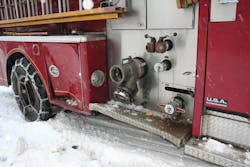For some reading this, winter may just have begun; for others, you may be well into winter. For new and seasoned apparatus operators this can be a very challenging time, to say the least. But questions come to mind: "What has your fire department done to prepare new apparatus operators for winter driving?" and "What has your fire department done to prepare experienced operators for winter driving?" The answers are as varied as the fire service itself. Preparing for winter driving in many cases acts as a snapshot of how the fire department is trained, organized, supervised and operates.
Some fire departments are supervised by the "fair-weather fire chief." The fair-weather fire chief will only let fire apparatus leave the fire station on driver training on a sunny, 70-degree Sunday. Yet this same chief has the expectation that apparatus are going to show up safely in all kinds of weather and conditions 24/7/365. In February, at night, with a 30-mph wind and six inches of snow on the road, going to a confirmed working fire with people trapped, it is no time for any operator — but especially a new operator — to figure out how the apparatus is going to handle and stop under these circumstances and conditions. Also, understanding that most apparatus operators are supposed to be familiar with and safely operate multiple types of apparatus built in different years by different manufacturers. This certainly sounds like a disaster waiting to happen.
Some fire departments have the "proactive fire chief" who encourages the department's apparatus operators to train in and for inclement weather. That is not to say that the fire chief should let apparatus operators train in a blizzard or an ice storm; common sense should prevail. However, letting operators take the apparatus to a large parking lot or some other controlled environment during daylight hours with several inches of snow cover to figure out how the apparatus and the operator are going to handle inclement weather seems to be a prudent approach. This is especially true if the chief wants the apparatus to show up in one piece during inclement weather, at night with the stress of a response.
Billy Goldfeder's "Firefighter Close Calls" website recently reported on an apparatus crash that was blamed on winter road conditions. Two Ontario firefighters were released from a hospital and were recovering from injuries suffered when their fire apparatus crashed. According to the website, "The men were responding to a car crash on Highway 401 around 9:15 A.M. Saturday when their vehicle lost control and collided with a tree. One of the men suffered a broken arm and the other suffered lacerations. A winter storm slicked roads and there was a flurry of calls to crashes and the police are blaming road conditions. The truck, a three-quarter-ton specially outfitted pickup, was totaled. The truck slid off the road and the driver's-side door was wedged against the tree."
Here are a few winter driving tips for apparatus operators:
- Braking— Start braking sooner than you would under normal driving conditions.
- Speed— Slow down! No one should expect the apparatus to show up in the same amount of time with six inches of snow on the ground versus dry pavement.
- Steep or long grades — Know your response area, slow down long before arriving at a steep or long grade, have the apparatus in the lowest gear and cover the brake. Always have a way out.
- Slippery pavement— On slippery, snowy or icy pavement, reduce your speed, drive slowly and with a heightened state of situational awareness.
- Winding and narrow roads — Keep well to the center of the lane; do not drift off the edge of the road. Drive slowly and scan ahead as far as you can.
- Corners — Slow down well in advance of the corner. Understand that the weight of the vehicle pushing you forward may well overpower your ability to maintain traction, control and steer the apparatus; it may just go straight.
- Turning — Slow down and signal your intentions long before the turn to warn others around you. As with cornering, understand that the weight of the vehicle pushing you forward may well overpower your ability to maintain traction, control and steer the apparatus and it may just go straight.
- Losing control when cornering — Most defensive-driving experts will advise you to steer into the turn, although human nature may have you react differently.
- Intersections — When approaching an intersection that has a green light, slow almost to a stop and understand that civilian drivers may not be able to stop in the snow or on the ice, regardless of the color of the light (Figure 1). When approaching a red light, come to a complete stop and make sure that all civilian drivers have stopped, are granting the right of way to you and are not going to slide into you.
- Auxiliary braking systems — When I drove in the snow, I would leave the engine brake on as long as I maintained traction and it would actually help me control and stop the vehicle. However, on ice, I would turn the engine brake off not wanting it to throw the apparatus into a skid or spin. Today, I would guide my actions based on the recommendations of the auxiliary brake manufacturer. This information is generally found in the auxiliary brake manufacturer's operators manual.
- Apparatus maintenance — Tires must have 4/32 inches of tread depth and should be mud-and-snow tires. Apparatus brakes must be in proper adjustment so that they do not grab and throw the vehicle into a skid or spin.
- Full chains — Full chains are generally put on for significant snowfall (six inches or more; Figure 2) or in the absence of automatic chains. Any chains in contact with the tires make it much harder to stop the apparatus, as there is less road surface area in contact with the tire.
About the Author
Michael Wilbur
MICHAEL WILBUR, who is a Firehouse contributing editor, retired as a lieutenant in FDNY, where he was last assigned to Ladder Company 27 in the Bronx. He has served on FDNY's Apparatus Purchasing Committee and consults on a variety of apparatus-related issues around the country. Wilbur is a member of the Firehouse Hall of Fame. For further information, access his website at www.emergencyvehicleresponse.com.

